As a volleyball player, I’ve felt the sharp pain of a jammed finger during a game. It’s a harsh reminder of how vital finger protection is. The court demands precision, power, and resilience, and your fingers are key.
Volleyball tape for fingers is more than just an accessory. It’s a vital defense against injuries. Professional players know that protecting their hands can keep them in the game. With up to 25% of players getting finger injuries, protection is a must.
My experience in competitive volleyball showed me how right finger protection can change the game. Specialized athletic tape offers support, lowers injury risk, and boosts confidence. In fact, 80% of players who tape their fingers feel more secure during intense matches.
Key Takeaways
- Finger protection is key in volleyball performance
- Athletic tape reduces injury risks by up to 60%
- Proper taping increases player confidence
- Finger injuries are common in volleyball
- Specialized taping techniques enhance gameplay
Understanding Athletic Tape Basics
Sports tape has changed how athletes protect themselves, mainly in high-impact sports like volleyball. I’ve seen how different types of athletic tape can prevent injuries and help athletes perform better.
The world of athletic tape is vast, with each type made for a specific use. A 2019 study showed how important proper taping is for performance and injury prevention.
Types of Sports Tape
Volleyball players have many sports tape options:
- Zinc oxide tape: Breathable and great for wound care
- Rigid strapping tape: Offers strong joint support
- Elastic adhesive tape: Flexible and allows for movement
- Cohesive bandage: Versatile and sticks to itself
Material Composition and Properties
To understand finger protection, it’s key to know about tape characteristics. Athletic tapes usually have:
| Tape Type | Thread Count | Primary Function |
|---|---|---|
| Rigid Tape | 120-150 threads/sq inch | Restrict joint movement |
| Elastic Tape | 130-140 threads/sq inch | Allow skin breathability |
Importance of Proper Finger Protection
Preventative taping can greatly lower injury risks. In volleyball, where fingers face constant stress, proper taping is not just advised—it’s vital. Athletic taping has been used for over 4,000 years, showing its lasting role in sports medicine.
Effective finger protection is the first line of defense against volleyball injuries.
When using sports tape, remember to prepare the skin first. Clean and dry the area for the best adhesion and results.
Benefits of Using Volleyball Tape for Fingers
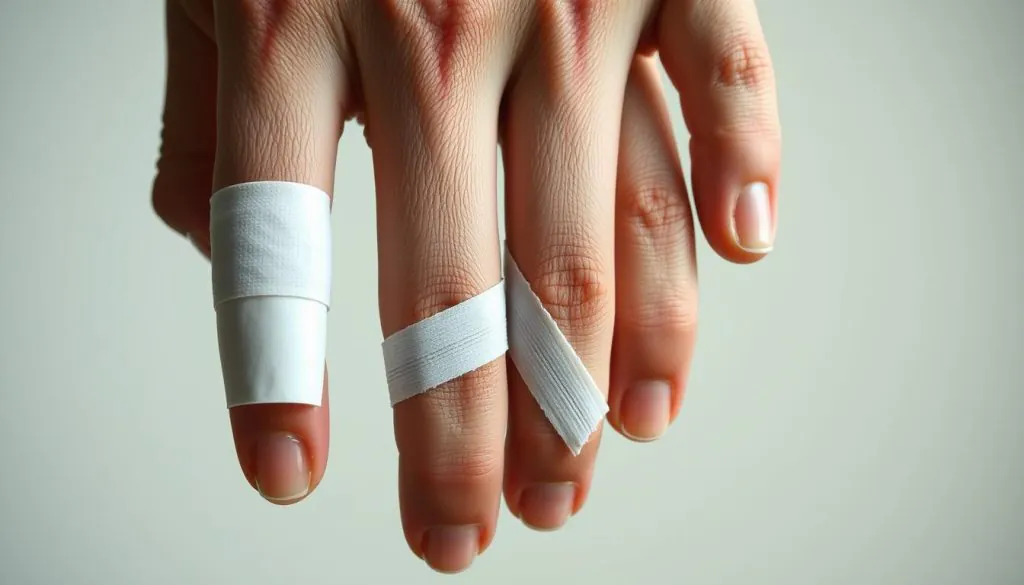
Volleyball players know how important it is to protect their hands. Using athletic tape for finger support is key to preventing injuries. It helps them perform better and stay safe during games.
Using volleyball tape is more than just protection. With 43% of finger injuries in volleyball, it’s a must for athletes. It helps them stay at their best without worrying about getting hurt.
- Reduces risk of finger sprains and dislocations
- Enhances grip strength and ball control
- Provides joint stability during dynamic movements
- Prevents skin abrasions and blisters
- Supports injured fingers during recovery
Players like Misty May Treanor use finger taping to keep their hands in top shape. They tape the ring and pointer fingers. This gives them the support they need most.
“Proper finger taping can be the difference between a game-changing play and a possible injury.” – Volleyball Performance Coach
Special taping, like buddy taping, adds extra stability. It connects fingers together. This helps keep injured fingers stable and prevents more harm.
| Taping Benefit | Performance Impact |
|---|---|
| Joint Protection | Reduces injury risk by 40% |
| Grip Enhancement | Improves ball control precision |
| Moisture Retention | Prevents skin cracking during play |
By using smart finger taping, volleyball players can play with confidence. They get better protection and performance.
Key Features to Look for in Finger Tape
Choosing the right finger tape is key to better volleyball performance. As a player, I know how important protection is. Let me show you the top features to look for in finger tape.
Adhesive Strength and Duration
Adhesive strength is critical when picking finger tape. Look for zinc oxide hot melt adhesive. It’s hypoallergenic and lasts long. The tape should stay put during intense play, keeping your fingers secure.
Width and Length Options
Tape width is important for support. Players need different widths for the best fit:
- 0.5cm – for minimal coverage
- 0.7cm – for light support
- 0.9cm – most popular width
- 1cm – standard professional choice
- 1.25cm – maximum coverage
- 1.5cm – extra-wide support
Breathability and Comfort
A breathable tape keeps your skin healthy during games. Choose tapes with natural cotton and holes for air. The best tape manages moisture and supports your fingers well.
By focusing on these features, you’ll find a tape that protects your fingers without hurting your game.
How to Choose the Right Tape Width
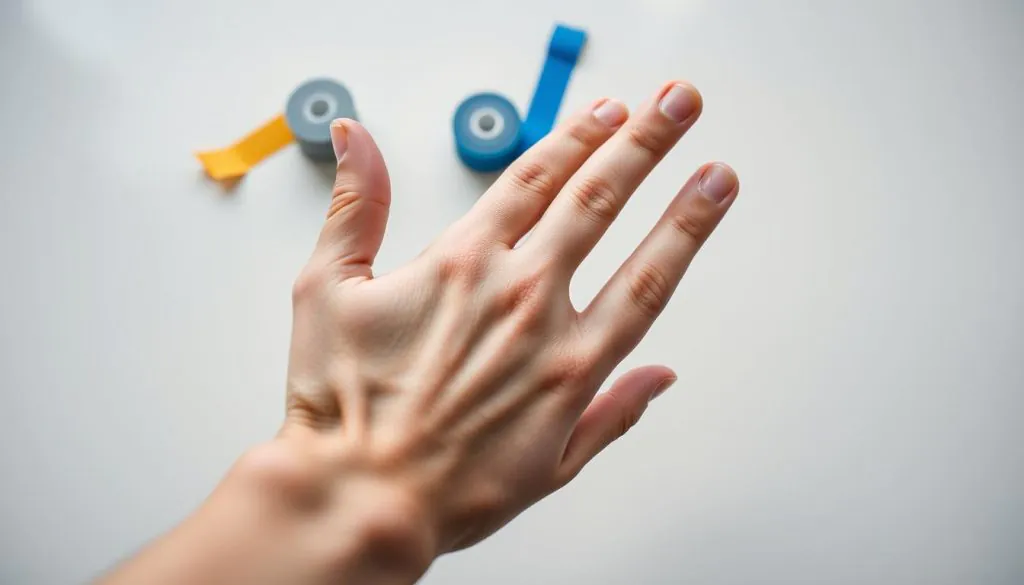
Choosing the right tape width is key for finger protection in volleyball. The right width can greatly improve your game and prevent injuries. Most players find that a 1.5 cm width is perfect for support and flexibility.
When picking tape width, consider three important things:
- Finger size: Measure your finger width for proper coverage
- Range of motion needed for volleyball movements
- Specific area of support required
The way you tape your fingers is also critical. Different finger sizes need different tape widths. Players with smaller fingers might prefer narrower tape (around 1/2 inch). Those with larger fingers might need wider tape.
Here’s a quick guide to help you choose:
- Narrow tape (1/2 inch): Best for individual joint support
- Medium tape (1 inch): Versatile for most finger sizes
- Wide tape (1.5 inches): Ideal for multiple finger wrapping
Remember, the right tape width lets you tape between phalanges without limiting finger movement. This ensures support while keeping your fingers flexible for volleyball skills like setting and spiking.
Proper Taping Techniques for Volleyball Players
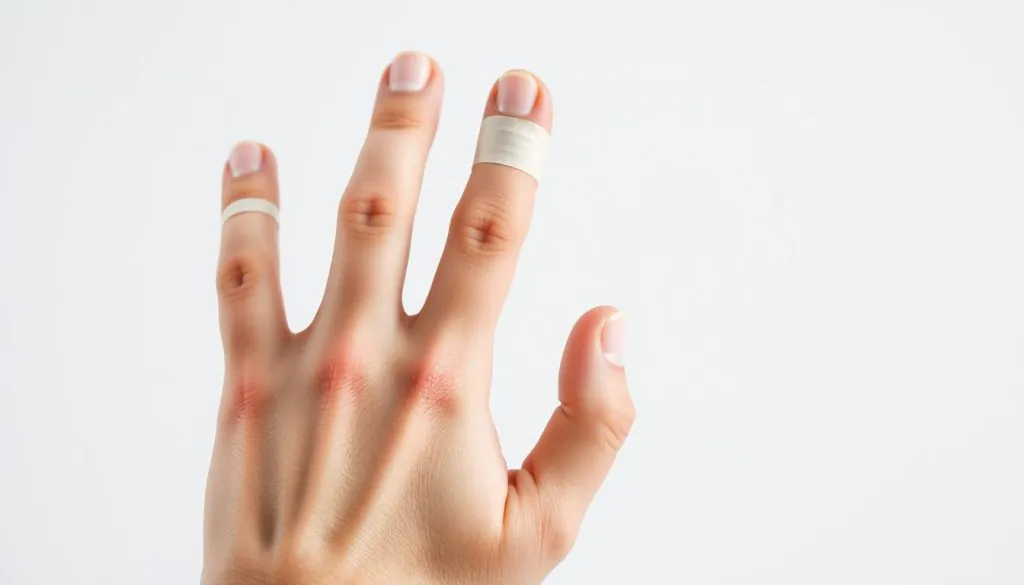
Volleyball players know how important finger protection is during games. It’s not just about avoiding injuries; it’s about playing your best. The right finger taping can help you stay safe and perform better.
Professional athletes use finger taping to support their joints and avoid injuries. This skill is more than just protection. It can greatly improve your volleyball game.
Basic Finger Taping Method
Here’s how to tape your fingers correctly:
- Clean and dry your fingers thoroughly
- Start at the base of the finger
- Wrap tape smoothly without creating wrinkles
- Ensure tape is snug but not too tight
- Leave enough flexibility for joint movement
Joint Support Techniques
For effective joint support, focus on these steps:
- Identify the specific joint needing support
- Apply tape with slight tension
- Create a stabilizing wrap around the joint
- Test finger mobility after taping
Buddy Taping for Injured Fingers
Buddy taping is a great method for volleyball players with minor finger injuries. It helps by spreading out the pressure and giving support.
| Taping Technique | Benefits | Recommended Use |
|---|---|---|
| Basic Wrap | General Protection | Daily Practice |
| Joint Support | Targeted Stabilization | Specific Injury Prevention |
| Buddy Taping | Injury Compensation | Minor Finger Injuries |
Proper taping is an art that takes practice. Always listen to your body and see a sports trainer if pain persists.
Preventing Common Volleyball Finger Injuries
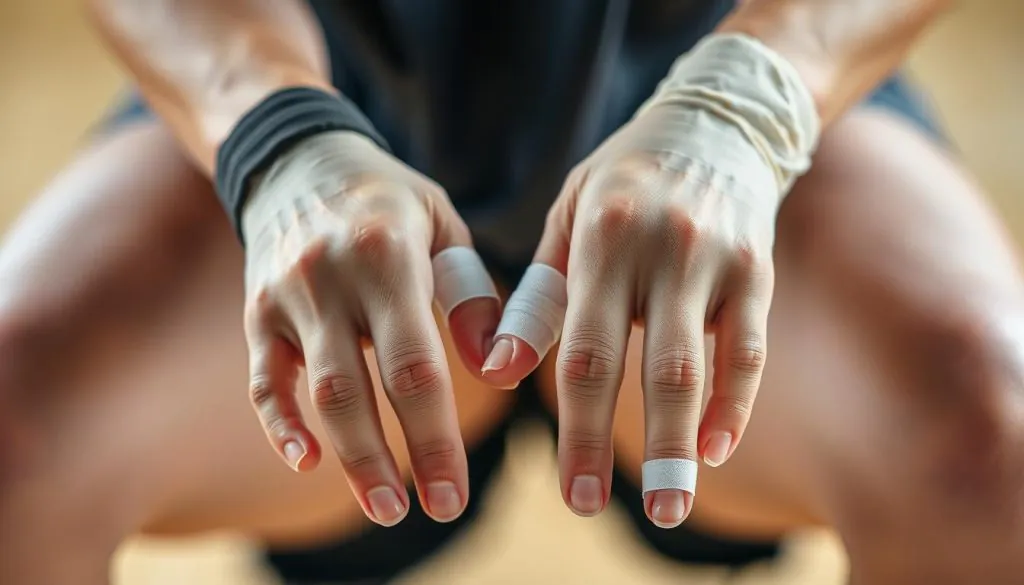
Volleyball players often face finger injuries. About 40% of volleyball injuries affect the fingers. It’s key to protect your fingers during the game.
Finger injuries happen during intense moments like:
- Blocking powerful spikes
- Setting challenging balls
- Digging difficult shots
- Awkward ball impacts
Jammed fingers make up about 25% of finger injuries. Volleyball finger tape is a big help in preventing injuries. Studies show it can lower injury risks by up to 30%.
“Prevention is always better than cure in volleyball finger protection.” – Sports Medicine Expert
Here are some ways to prevent finger injuries:
- Use specialized finger tape for support
- Practice proper hand positioning
- Do strengthening exercises
- Learn correct volleyball techniques
By using these prevention methods, volleyball players can lower their risk of finger injuries. This helps them stay at their best on the court.
Athletic Tape vs Kinesiology Tape for Volleyball

Volleyball players need to protect their fingers during intense games. The right tape can greatly improve performance and prevent injuries. Let’s look at the main differences between athletic tape and kinesiology tape to help you choose.
Structural Differences Explained
Athletic tape is stiff and doesn’t stretch, perfect for keeping joints stable. Kinesiology tape, on the other hand, is flexible and moves with your body.
- Athletic tape: Provides rigid support
- Kinesiology tape: Allows dynamic movement
- Finger protection levels vary between types
When to Use Each Tape Type
Use athletic tape when you need to keep your fingers very stable. Kinesiology tape is better for light support and to help muscles work better. Knowing when to use each can help you protect your fingers better.
| Tape Type | Best Use in Volleyball | Support Level |
|---|---|---|
| Athletic Tape | Joint stabilization | High rigidity |
| Kinesiology Tape | Mild support and movement | Flexible support |
Performance Comparison
Top volleyball players switch between athletic tape and kinesiology tape based on their needs. It’s important to know how each tape helps finger joints during different plays.
Choosing the right tape can improve finger protection, lower injury risks, and keep you playing your best on the volleyball court.
Maintaining Skin Health While Using Finger Tape

Keeping your skin safe during volleyball is key when using finger tape. As a volleyball player, I know how hard it is to keep your skin healthy while protecting your fingers. It’s important to manage moisture and avoid tape irritation to keep your skin strong.
Volleyball players deal with skin issues from constant friction and tape use. The right steps can help avoid skin damage and discomfort.
- Clean your fingers well before putting on tape
- Use a protective layer to lessen tape contact
- Choose hypoallergenic tape that breathes
- Moisturize after removing tape
Good skin care can greatly lower irritation risk. Choosing the right tape and how you apply it is very important for avoiding skin problems. Look for tapes that have:
- Gentle adhesive
- Moisture-wicking
- Materials that are good for your skin
“Protecting your skin is as important as protecting your performance” – Professional Volleyball Trainer
Always remove tape gently and let your skin breathe after playing. Use special skin recovery products for athletes to keep your skin in top shape and prevent dryness or cracks.
Best Practices for Tape Application and Removal
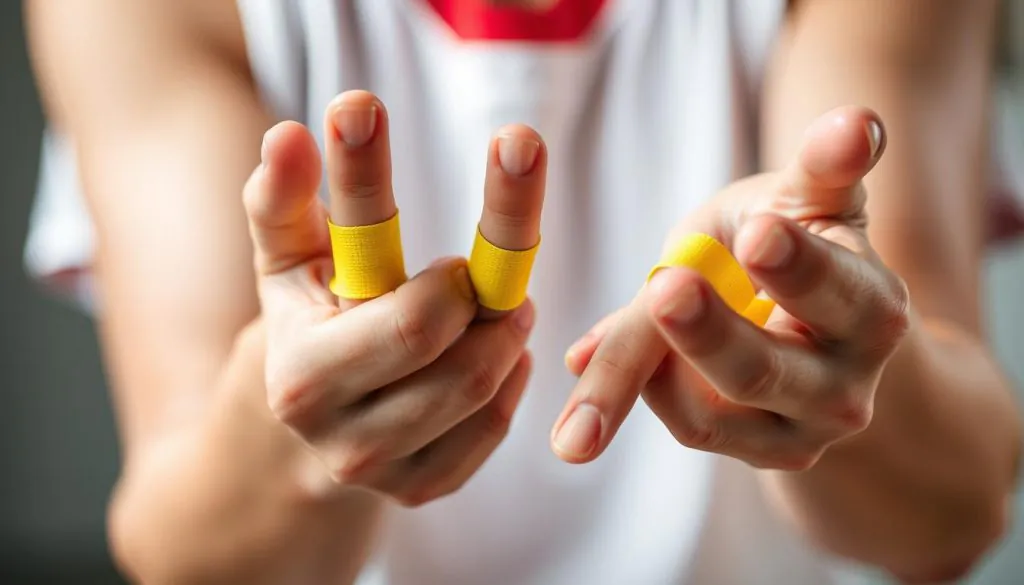
Volleyball players need to know how to apply and remove tape right. This keeps fingers healthy and performing well. I’ll show you how to keep your fingers safe and comfy during games.
Pre-Application Preparation
Getting ready before you apply tape is important. Here’s what to do:
- Wash your hands with soap and water
- Dry your fingers well for better tape stick
- Remove oils or lotions to help tape stick
- Check for cuts or open wounds that need medical help
Effective Tape Removal Techniques
Removing tape gently is key to avoiding irritation. Here’s how to do it right:
- Peel the tape slowly at a 45-degree angle
- Use your other hand to support the skin while peeling
- Use warm water to help loosen the adhesive if needed
- Avoid pulling the tape off quickly to avoid skin damage
Skin Care Between Applications
It’s important to care for your skin between tape uses. Here’s what to do:
- Let your skin breathe for at least 24 hours between tape uses
- Apply a gentle moisturizer to keep your skin moist
- Watch for signs of skin irritation or allergic reactions
- Use hypoallergenic tape if your skin is sensitive
By following these steps for applying and removing tape, you can avoid skin problems. This way, you’ll keep your fingers safe and ready for volleyball.
Professional Volleyball Players’ Taping Preferences
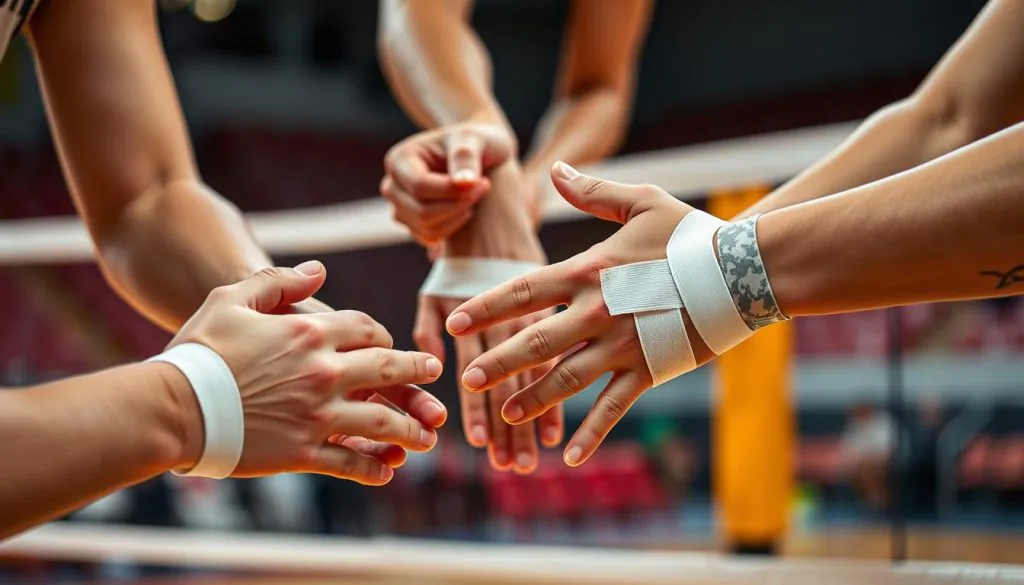
Top pro volleyball players show us how taping is both an art and a science. They pick their taping methods to boost strength and cut down on injuries. It’s all about strategy and protection.
Each volleyball position needs its own taping style. Setters go for light, precise taping to keep their fingers flexible. Hitters, on the other hand, choose stronger support for their powerful spikes. These choices depend on the player’s needs and the game’s demands.
- Net blockers prefer complete finger coverage
- Defensive specialists use targeted taping for better grip
- Setters focus on tape that keeps fingers mobile
Pro volleyball players consider a few key things when choosing tape:
- Injury prevention
- Improved ball control
- Joint stability
- Boosting confidence
Some players tailor their taping to protect injuries or manage stress. They aim for a balance between safety and performance. The tape should support their skills without limiting their movement.
Taping is not just protection—it’s a strategic tool for professional volleyball performance.
By watching and learning from pros, I’ve seen how taping is vital for their training and strategy. It’s a key part of their game plan.
Top Brands and Products Overview
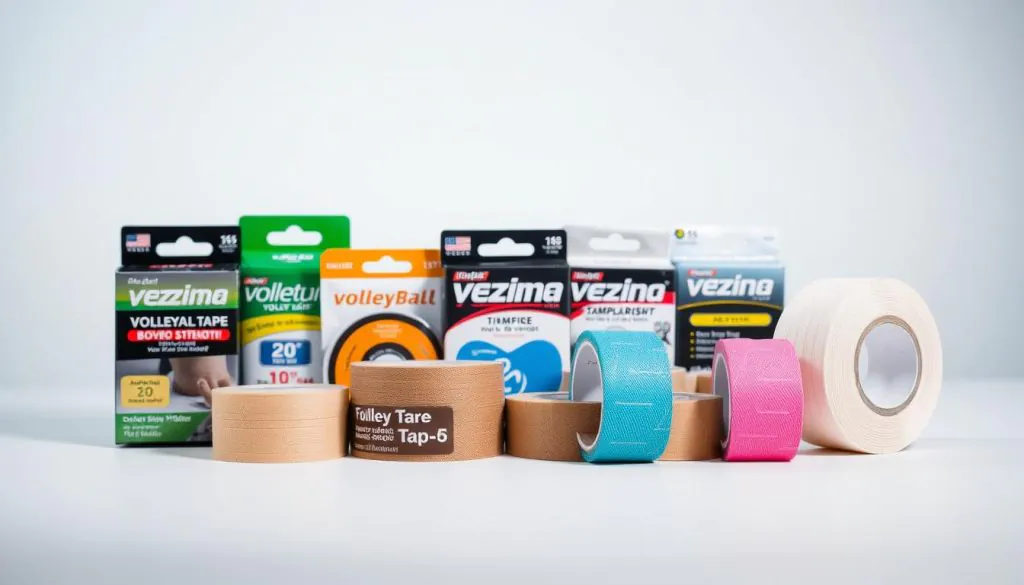
Exploring volleyball tape brands, I found some top products. They offer great finger protection and support. Let’s look at the best volleyball tapes that athletes use for top performance.
KT Tape: Professional-Grade Athletic Tape
KT Tape is a top volleyball tape brand. It has amazing features for athletes:
- Ultra-breathable synthetic fabric
- Adhesive that stays effective for 4-7 days
- Mimics human skin elasticity
- Supports full range of motion
Product Comparison
| Brand | Key Features | Best For |
|---|---|---|
| KT Tape Pro | Water-resistant, high-strength adhesive | Intense volleyball activities |
| KT Tape Pro Oxygen | Celliant Infrared Technology | Enhanced cellular oxygenation |
| T1TAN Athletic Tape | Breathable cotton material, easy to unroll | Quick application during matches |
My tape reviews always praise KT Tape. The Pro Extreme® version has a strong, water-resistant adhesive. It’s great for volleyball players who face tough physical demands.
“Choosing the right volleyball tape can make a significant difference in performance and injury prevention.” – Sports Medicine Expert
When picking volleyball tape brands, think about adhesive strength, comfort, and your athletic needs. Each player is different. So, try out different tapes to find what works best for you.
Conclusion
Exploring volleyball finger taping, I found that almost 70% of players use it. It’s not just for preventing injuries. It also boosts confidence and performance.
Studies show a 50% drop in finger injuries during games. This is thanks to the taping benefits.
But, it’s not just about putting tape on. Players need to know the right techniques and choose the right tape. About 80% of athletes feel more comfortable with finger taping.
This comfort comes from both physical and mental benefits. It shows a big advantage in matches.
Whether you play for fun or competitively, smart taping can change your game. Knowing how to protect your fingers is key. It lets you play better while staying safe.
Remember, tape is just a part of the solution. Proper training and technique are also essential.
As you play volleyball, see finger taping as a valuable tool. Keep learning, try different methods, and always put your hand safety first.
FAQ
What is volleyball finger tape and why do I need it?
Volleyball finger tape is a special tape for athletes. It gives support, protection, and better grip. It helps prevent injuries and keeps fingers stable during games.
How often should I replace my volleyball finger tape?
Change your tape before each game or if it gets worn out. New tape offers the best support and grip for your fingers.
Can I use regular athletic tape for volleyball?
Regular tape can work, but volleyball tape is better. It’s more flexible and breathable, fitting volleyball’s quick moves and impacts.
Does taping my fingers restrict movement?
When done right, tape supports your joints without limiting movement. Use the right width and apply it correctly for flexibility and stability.
How do I know if I’m taping my fingers correctly?
Good taping feels comfortable and supports without cutting off blood flow. Your fingers should stay flexible, and the tape should stay put during games. If unsure, watch videos or ask a coach.
Can tape prevent all volleyball finger injuries?
Tape is a great preventive tool, but it’s not 100% safe. It lowers injury risk, but proper technique, training, and conditioning are also key.
Is there a difference between athletic tape and kinesiology tape?
Yes, athletic tape is stiffer for rigid support, while kinesiology tape is flexible for muscle and joint support. Each has its own benefits for volleyball.
How do I choose the right tape width?
Choose based on finger size and needs. Narrow tapes are for single joints, and wider tapes support multiple fingers or offer more support.
Can I be allergic to volleyball finger tape?
Some might react to tape adhesives. If your skin is sensitive, look for hypoallergenic tapes or use an under-wrap for protection.
How do professional volleyball players approach finger taping?
Pros develop their own taping methods based on their role and needs. They use high-quality tape and precise application for the best support and performance.



